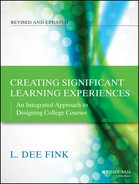NOTE TO UPDATED EDITION
It has been ten years since the original publication of this book. When writing a book like this, you are inclined to believe the ideas have some value but you don’t know whether others will also value the ideas until you see how they respond to the book. It has been extremely rewarding and humbling to see how widely the book has been accepted and used. Reports from individual professors on the impact of these ideas have been very heartwarming.
Part of this success, of course, can be attributed to several changes that have been occurring in higher education. In the United States—and even more so in some other countries—civic and higher education leaders have felt a growing concern that even when students graduate from college, they are not learning what they need to be learning to face the challenges of life in the twenty-first century. In his influential book, The World Is Flat (2005), Thomas Friedman described how the world has become interconnected in multiple ways here at the beginning of the current century. Based on this, he also argued that all countries need college graduates who have a new and better kind of learning that will equip them to deal with the challenges and the opportunities of this more-complex world.
The next year Derek Bok, then-president of Harvard University, published a widely read book, Our Underachieving Colleges: A Candid Look at How Much Students Learn and Why They Should Be Learning More (2006). He gathered data from already existing research on how well college students in the United States are achieving eight kinds of generally valued kinds of learning, for example, communication skills, critical thinking, character, preparation for citizenship, living with diversity, and so on. With all eight kinds of learning, his conclusion was the same: students are achieving some of this learning but nowhere near the level that they could and should be achieving.
At the same time this realization was spreading, the concept of “learning-centered higher education” has been steadily gaining acceptance. Basically this perspective believes that our institutions should be focused not just on offering courses and granting degrees but also on generating valuable kinds of learning and certifying that those kinds of learning have been achieved.
These changes have led people to ask what college students should be learning and how these kinds of learning can be achieved more widely. With these questions, there has been an increasing realization that, regardless of whether the learning is being done in traditional, face-to-face settings or in an online environment, these important—or in my language—significant kinds of learning need to be designed into individual courses and built into the curriculum. Only then will there be a high likelihood that most students will achieve the kinds of learning that they and society need for them to achieve.
These changes in higher education were the context into which the original edition of my book was published in 2003. Partially as a result of all this, many people quickly saw the value of my taxonomy of significant learning for defining what those important kinds of learning might be. And the model of integrated course design offered a learning-centered approach for designing that significant learning into a course or even a curriculum.
As a result of this fortuitous timing, the original book was rapidly and widely embraced. It became one of Jossey-Bass’s best sellers; it has been adopted as a textbook for many graduate courses on college teaching; it has been translated into four languages as of this date; and I have been invited to do workshops on the ideas of the book on campuses in nearly every state in the United States and nearly every region of the world. In fact, the volume of workshop requests prompted me to recruit other experienced workshop leaders to conduct some of these workshops; this group is known now as Dee Fink & Associates.
My experience doing these workshops forms the first reason for my needing to update the book. Although the basic ideas and their layout in this book remain sound and do not need any major changes, I have learned a lot from workshop participants and from the associates about what helps college teachers understand these ideas as fully as possible.
The other reason for wanting to update the book is that, during the past decade, numerous researchers and writers have continued to publish books with extremely valuable ideas on college teaching as part of their work in the scholarship of teaching and learning (SoTL). Consequently I felt a need to update some of the literature cited in the book.
Given all this, what changes have I made here? In numerous places throughout the book, I have clarified the language and terminology. In some cases, I have expanded and refined the comments about the concepts themselves, for example, when discussing the task of integrating the course and procedures for evaluating the design of the course.
Another substantial change occurs in Chapter Six, which is about organizational support for better teaching and learning. I have added comments there to reflect some of the national and global changes that, for the most part, are having a positive influence on the support needed.
And finally, as already mentioned, I have incorporated references to many of the new books on college teaching that have been written in the last decade by the dedicated and talented scholars of SoTL! This community of thinkers, teachers, and writers are building a body of ideas that are already making a difference and will continue to be even more influential as world leaders grow in their realization of the importance of high-quality teaching and learning in colleges and universities everywhere.
| March 2013 | L. Dee Fink |
